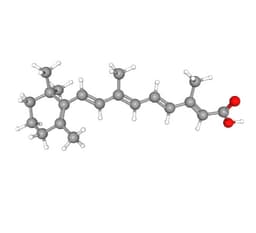Tretinoin

Summary: The active, prescription-strength form of vitamin A that works up to 10x more effectively than retinol, but is less stable and more irritating.
Published on: 11/08/2025
Tretinoin (retinoic acid) is the active form of vitamin A that binds directly to nuclear retinoic acid receptors in skin cells, requiring no metabolic conversion. This makes it significantly more potent than retinol (around 10x), which must be oxidized twice to reach the active form [1,2].
Comparison with Retinol
| Feature | Retinol | Tretinoin (Active Form) |
|---|---|---|
| Potency | Requires two enzymatic conversions before becoming active. | Already active; binds directly to retinoic acid receptors—no conversion loss [1]. |
| Magnitude of Effect | Improved photodamage scores, fine lines, and skin texture [2]. | Achieved comparable clinical and histologic improvements at ~1/10th the concentration used for retinol (e.g., 0.05% tretinoin ≈ 0.5% retinol) in a split-face randomized controlled trial. [2]. |
| Tolerance | Erythema, peeling, and dryness reported; generally milder in controlled testing [3]. | More frequent and more severe erythema, peeling, and dryness than retinol in direct testing [3]. |
Photostability & Formulation
Unprotected tretinoin degrades rapidly when exposed to light and oxidizing agents. In controlled in-vitro testing, conventional tretinoin gel 0.025% lost up to 69% of active ingredient after 24 hours of fluorescent light exposure, and up to 89% when combined with an erythromycin–benzoyl peroxide gel [4]. In another study, the same conventional gel lost >83% of its tretinoin content within just two hours under fluorescent light, and >85% degradation occurred under all simulated solar light exposure levels [5].
Encapsulation technologies markedly improve stability. Tretinoin gel microsphere 0.1% retained 98% of its content after 24 hours of fluorescent light exposure [4]. Micronized tretinoin gel 0.05% degraded by only 9–11% after 8 hours of fluorescent light exposure, and exhibited a gradual, dose-dependent degradation under simulated solar light [5]. Packaging in opaque, airtight containers further helps protect against light- and oxygen-induced degradation.
References
-
Mukherjee S., Date A., et al. (2006). Retinoids in the treatment of skin aging: an overview of clinical efficacy and safety. Clinical Interventions in Aging, 1(4), 327–348. https://pmc.ncbi.nlm.nih.gov/articles/PMC2699641/
-
Babcock, M., Mehta, R. C., Makino, E. T., et al. (2015). A randomized, double-blind, split-face study comparing the efficacy and tolerability of three retinol-based products vs. three tretinoin-based products in subjects with moderate to severe facial photodamage. Journal of Drugs in Dermatology, 14(1), 24–30. https://pubmed.ncbi.nlm.nih.gov/25607905/
-
Fluhr J.W., Vienne M.P., Lauze C., et al. (1999). Tolerance profile of retinol, retinaldehyde and retinoic acid under maximized and long-term clinical conditions. Dermatology ;199(1):57–60. https://pubmed.ncbi.nlm.nih.gov/10473963/
-
Nyirady J., et al. (2002). The stability of tretinoin in tretinoin gel microsphere 0.1%. Cutis, 70(5), 295–298. https://pubmed.ncbi.nlm.nih.gov/12469785/
-
Del Rosso, J. Q., Harper, J., Pillai, R., et al. (2013). Tretinoin photostability: comparison of micronized tretinoin gel 0.05% and tretinoin gel 0.025% following exposure to fluorescent and solar light. Journal of Clinical and Aesthetic Dermatology, 6(2), 25–28. https://pmc.ncbi.nlm.nih.gov/articles/PMC3579485/